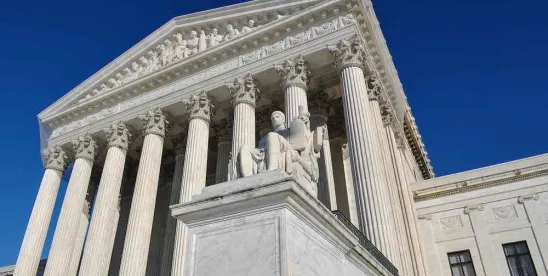Last week, the United States Supreme Court granted certiorari in NVIDIA Corp. v. E. Ohman J:Or Fonder AB., Case No. 23-970, to address two fundamental questions about how federal securities fraud cases must be pled to survive a motion to dismiss—an issue that arises in nearly every such case.
In order to properly state a claim for fraudulent misstatements or omissions under Section 10(b) of the Securities Exchange Act of 1934, the Private Securities Litigation Reform Act of 1995 (“PSLRA”) requires plaintiffs, among other things, to: (1) plead “facts giving rise to a strong inference that the defendant acted with the required state of mind” (i.e., fraudulent intent); and (2) “state with particularity all facts” supporting a claim of falsity (i.e., demonstrate that the statement or omission at issue was, in fact, misleading).[1]
The Supreme Court is set to weigh in on whether plaintiffs can meet the PSLRA’s pleading requirements for scienter and falsity, respectively, by: (1) alleging without specificity that internal company documents contradicted the defendant’s public statements; and (2) relying on expert opinion to create an inference of falsity as a substitute for particularized allegations of fact. While the Ninth Circuit recently allowed such allegations to satisfy the PSLRA’s “strong inference” and “particularity” requirements, other courts (and petitioning defense counsel) contend that they are insufficient.
The case, to be heard during the upcoming 2024–2025 term, adds to the roster of recent high-profile Supreme Court cases concerning securities class actions (including Facebook, Inc. v. Amalgamated Bank, which the Court is also set to decide next term) and is likely to have a significant impact on how such cases are litigated going forward.
NVIDIA’s Petition for Certiorari
In petitioning for certiorari, the electronic chip manufacturer NVIDIA sought review of the Ninth Circuit’s interpretation of the PSLRA to revive investors’ claims regarding the company CEO’s alleged knowledge of the underlying drivers of NVIDIA’s graphics processing unit (“GPU”) chip demand and, specifically, whether the CEO knowingly understated the degree to which crypto asset mining operations was driving such demand (an issue that allegedly became apparent when NVIDIA’s GPU chip sales declined after the “crypto winter” in 2018).
NVIDIA explains that plaintiffs sought to establish their claims neither by alleging the actual number of NVIDIA GPU chips used by crypto miners nor by alleging that NVIDIA’s CEO actually possessed such data, but instead by: (1) hiring an expert to analyze public data about crypto mining activities and the amount of computing power needed to conduct those activities and to estimate the number of GPUs required for such activities and the percentage of such GPUs that were likely manufactured by NVIDIA; and (2) alleging, based on confidential witness testimony, that internal NVIDIA documents analyzed GPU sales and usage data, without citing the specific contents of those documents, or whether NVIDIA’s CEO knew about the contents of the documents before he commented on the company’s GPU sales.
While the district court found that plaintiffs’ allegations did not satisfy the PSLRA’s “strong inference” and “particularity” pleading requirements, and therefore dismissed the complaint, the Ninth Circuit reversed. In its petition for Supreme Court review, NVIDIA contended that plaintiffs’ expert report lacked particularity, and instead presented a “chain of dubious assumptions” in an attempt to show that NVIDIA had generated more revenue from sales to crypto miners than had been publicly disclosed, and that plaintiffs’ scienter allegations were based on pure speculation “about what internal company documents might have said, without any particularized allegations about what the documents actually said” and, therefore, could not support a strong inference of fraudulent intent.
According to NVIDIA, the Ninth Circuit’s holding permitting the case to go forward is not only erroneous, but also contrary to decisions from five circuit courts of appeal (the Second, Third, Fifth, Seventh, and Tenth), which require plaintiffs who seek to plead scienter based upon internal contradictory corporate documents to plead with particularity the “actual contents of internal company documents allegedly reviewed by the relevant company executives” (often through confidential witness statements), and from two circuit courts of appeal (the Second and Fifth), which have held that expert opinion cannot function as a proper substitute for particularized allegations of falsity. The petition highlighted in particular the circuit split between the Second and the Ninth Circuits on these issues, since those two circuits “dominate the market for class action securities fraud litigation,” with “approximately 60% of federal class action securities fraud litigation activity.”
Conclusion
Scienter and falsity are two fundamental and, as a result, highly litigated elements of securities fraud cases. Indeed, almost every motion to dismiss a federal securities class action lawsuit challenges the sufficiency of plaintiffs’ allegations concerning one or both of those elements. As a result, the Supreme Court’s forthcoming views on how those elements can be established for pleading purposes are likely to have a very significant impact on how such cases are litigated going forward. Moreover, the case could have a relatively wide-ranging impact, since recent studies show that nearly 4% of all publicly-listed companies are sued for supposed securities fraud in any given year. We will continue to monitor the case.
[1] 15 U.S.C § 78u-4(b)(1), (2)(A).







 />i
/>i


